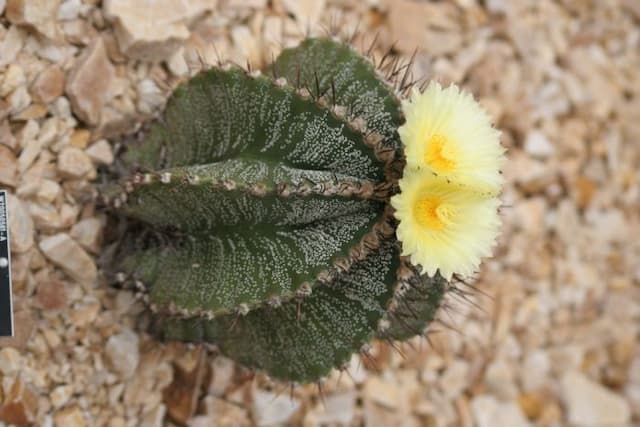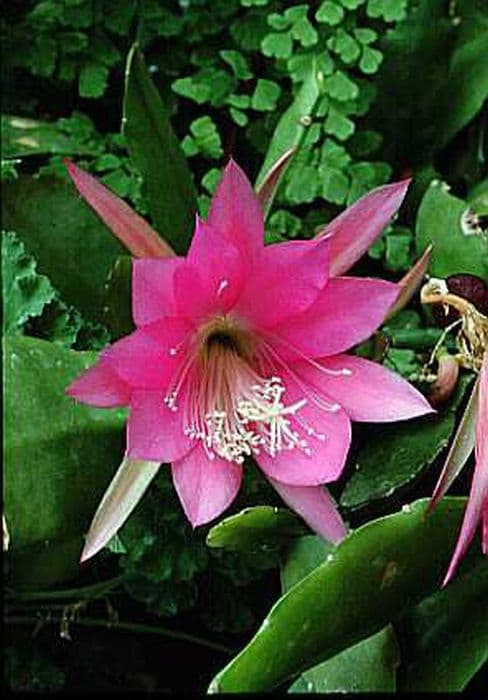Golden Ball Cactus Parodia leninghausii

ABOUT
The plant in question is commonly known as the Golden Ball Cactus or Yellow Tower Cactus. It's a striking cactus characterized by its long, cylindrical shape, which is densely covered in bright, golden-yellow spines that give it a sunny, cheerful appearance. The spines are soft and hair-like, covering the ribbed surface of the cactus, providing a unique texture that contrasts the typical sharpness associated with cacti. This cactus has a columnar growth habit, often growing straight upwards with a uniform diameter throughout its length. The surface of the Golden Ball Cactus is divided into multiple vertical ribs, which run from the base to the apex. These ribs are not just for structural support; they also help the plant expand and contract with fluctuations in water storage. Between these ribs, the areoles, or small, specialized structures from which spines emerge, are spaced evenly. The areoles are the points where the bright spines develop and protrude outwards, creating a halo effect around the cactus. The Golden Ball Cactus blooms with lovely flowers that add an extra dimension of beauty to the plant. These flowers are typically yellow and appear at the top of the cactus, forming a crown-like ring. The blooms open during the daytime and often attract pollinators with their bright coloration and nectar. After flowering, the plant may produce small, spherical fruits that bear seeds, continuing the plant's life cycle. The overall charm of this cactus lies in its glowing spiny exterior, which glints in the sunlight, and its capacity to produce vibrant flowers, making it a popular choice for cactus enthusiasts and a striking addition to gardens or indoor collections.
About this plant
 Names
NamesFamily
Cactaceae
Synonyms
Lemon Ball, Yellow Tower, Golden Ball Cactus, Lemon Ball Cactus, Golden Ball
Common names
Echinocactus leninghausii, Notocactus leninghausii, Malacocarpus leninghausii, Parodia lenninghausii.
 Toxicity
ToxicityTo humans
The plant commonly known as Golden Ball Cactus is not known to be toxic to humans. There is no significant risk of poisoning from ingesting any part of this cactus, but as with any plant, individual allergic reactions or mechanical injuries from the spines may occur.
To pets
The Golden Ball Cactus is also generally considered non-toxic to pets. However, ingestion of cactus parts can lead to gastrointestinal upset or obstruction, and the spines may cause mechanical injury if a pet tries to consume or play with the plant.
 Characteristics
CharacteristicsLife cycle
Perennials
Foliage type
Evergreen
Color of leaves
Green
Flower color
Yellow
Height
1 feet 4 inches (0.4 meters)
Spread
6 inches (15 centimeters)
Plant type
Cactus
Hardiness zones
9
Native area
South America
Benefits
 General Benefits
General Benefits- Low Maintenance: Parodia leninghausii, commonly known as Golden Ball cactus, is relatively easy to care for, requiring minimal attention.
- Drought Tolerant: It can survive with little water, making it ideal for xeriscaping and water-conservation gardens.
- Aesthetic Appeal: With its golden-yellow spines and columnar growth, it is visually striking and adds aesthetic value to any setting.
- Long Lifespan: This cactus species can live for many years with proper care, becoming a long-term companion.
- Indoor & Outdoor Versatility: It can thrive both indoors in pots and outdoors in suitable climates, offering flexible placement options.
- Non-Toxic: It is safe to keep around pets and children, as it does not contain harmful toxins.
- Seasonal Flowers: It blooms with attractive yellow flowers, providing seasonal interest and beauty.
 Medical Properties
Medical PropertiesThis plant is not used for medical purposes.
 Air-purifying Qualities
Air-purifying QualitiesThis plant is not specifically known for air purifying qualities.
 Other Uses
Other Uses- Photography: Golden Ball Cactus is popular among photographers for macro photography due to its intricate spine patterns and bright yellow coloring.
- Educational Tool: It is used in schools and educational programs to teach about cacti, succulents, and adaptation strategies of plants in arid environments.
- Artwork Subject: Its unique form and texture make it a frequent subject for botanical artists and illustrators.
- Modelling and Design: The geometric shape and orderly spine arrangement of the Golden Ball Cactus are sometimes replicated in modern design and architecture.
- Feng Shui: Some believe that adding a Golden Ball Cactus to the home or office can bring positive energy, as in the practice of Feng Shui.
- Theme Gardens: It can be used in thematic garden designs, such as xeriscapes or rock gardens, to create a focal point or highlight textures.
- Cultural Symbols: In some cultures, cacti including the Golden Ball Cactus, can symbolize warmth, protection, and endurance.
- Hobby Crafting: Miniature landscapes or fairy gardens often incorporate small cacti like the Golden Ball Cactus as part of the scenery.
- Stress Relief: Caring for a Golden Ball Cactus is said to offer a form of stress relief and mindfulness as gardeners focus on the needs of the plant.
- Science Projects: Students might use the Golden Ball Cactus in experiments to understand plant water retention or the effects of sunlight on growth.
Interesting Facts
 Feng Shui
Feng ShuiThe Lemon Ball Cactus is not used in Feng Shui practice.
 Plant Symbolism
Plant Symbolism- Resilience: Parodia leninghausii, commonly known as 'Golden Ball Cactus,' symbolizes resilience due to its ability to thrive in harsh, arid environments and adapt to limited water resources.
- Longevity: This plant represents longevity, as it can live for many years and grow very slowly over time, showing persistence and the ability to overcome the challenges of time.
- Protection: With its sharp spines, the Golden Ball Cactus is seen as a symbol of protection, guarding against negativity and harm while promoting a safe space.
- Radiance and Warmth: Its yellow to golden spines can be associated with radiance and warmth, emitting a bright and positive energy that reflects optimism and happiness.
- Beauty in Simplicity: The cactus, with its minimalist form and beauty despite its spartan environment, symbolizes finding and appreciating beauty in simple, unadorned places.
 Water
WaterGolden Barrel Cactus should be watered thoroughly when the top inch of the soil feels dry to the touch. During the active growing season, typically from spring to fall, this may mean watering every one to two weeks with approximately 10-12 ounces of water, depending on the size of the pot and the environmental conditions. In winter, reduce watering to once a month or less, as the plant goes dormant and requires less moisture. Always make sure the pot has good drainage to prevent root rot. Overwatering can be as harmful as under-watering for this cactus, so err on the side of caution and check the soil moisture before watering.
 Light
LightGolden Barrel Cactus thrives best in bright, direct sunlight for several hours a day. It prefers a south-facing window where it can bask in full sun exposure, as this mimics its natural desert habitat. If placed outdoors, ensure it receives unfiltered sunlight for most of the day. Avoid low light conditions as they can lead to etiolation, where the cactus becomes stretched and weak.
 Temperature
TemperatureGolden Barrel Cactus ideally enjoys temperatures between 70°F and 100°F, which are common in its natural desert habitat. It can survive brief periods of colder weather, down to about 50°F, but temperatures below this can cause damage to the plant. Avoid exposure to frost and ensure the cactus is kept in a warm environment during the winter months.
 Pruning
PruningPruning is not generally required for Golden Barrel Cactus. Pruning may be necessary to remove any dead spines or damaged tissue to maintain its appearance. If pruning is needed, it should be done carefully with clean, sharp tools to avoid injury to the plant. Any significant pruning should be done during the growing season when the cactus can recover more efficiently.
 Cleaning
CleaningAs needed
 Soil
SoilThe Golden Ball Cactus thrives in a well-draining soil mix, consisting of a combination of peat or coco coir, perlite, and coarse sand. Aim for a slightly acidic to neutral pH between 6.0 and 7.5 to ensure optimal growth.
 Repotting
RepottingGolden Ball Cacti should be repotted every two to three years to provide fresh soil and accommodate root growth, best done during the spring or summer months.
 Humidity & Misting
Humidity & MistingGolden Ball Cactus prefers low to moderate humidity levels, typical of indoor environments, without the need for specialized humidity conditions.
 Suitable locations
Suitable locationsIndoor
Place in bright, indirect sunlight and keep in a warm spot.
Outdoor
Needs full sun to partial shade and well-drained soil.
Hardiness zone
9-11 USDA
 Life cycle
Life cycleParodia leninghausii, commonly known as Yellow Tower cactus, begins its life cycle as a seed, which, under suitable conditions of warmth and moisture, will germinate and develop into a tiny seedling — a process that can take two weeks to several months. As the seedling grows, it develops spines and characteristic yellow color, entering a juvenile phase that lasts for several years until it reaches maturity. During the maturation phase, the cactus elongates and produces more ribs and spines, growing slowly and can reach up to 3 feet tall. Once mature, the Yellow Tower cactus blooms in the spring or summer, producing yellow flowers at the crown, usually when the cactus is about 30 cm tall, indicating that it has reached reproductive age. After pollination, which can be facilitated by insects or human assistance, the flowers develop into fruit that contains seeds, thus completing the reproductive cycle. The cactus can live for many decades, with individual plants often reaching ages of over 30 years in cultivation.
 Propogation
PropogationPropogation time
Spring-Summer
The Golden Ball Cactus, Parodia leninghausii, is commonly propagated through seeds. The best time to sow seeds is in spring when the temperatures are consistently warm, which is crucial for germination. To propagate, fill a shallow tray or pot with a well-draining cactus mix and sprinkle the tiny seeds over the soil. Lightly cover the seeds with a thin layer of sand or fine grit, and mist the surface to moisten it without causing the seeds to float away. Cover the container with transparent plastic or glass to maintain high humidity and place it in a bright, warm location out of direct sunlight. Keep the soil consistently moist but not waterlogged. Seedlings should appear in a few weeks to a few months, depending on the temperature and conditions. Once they are large enough to handle, they can be carefully transplanted into individual pots.









